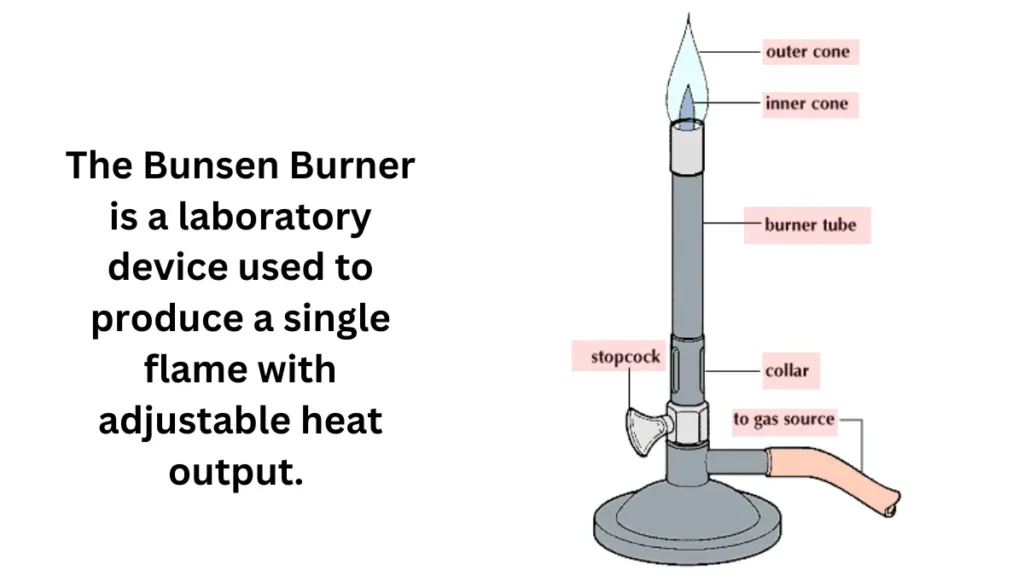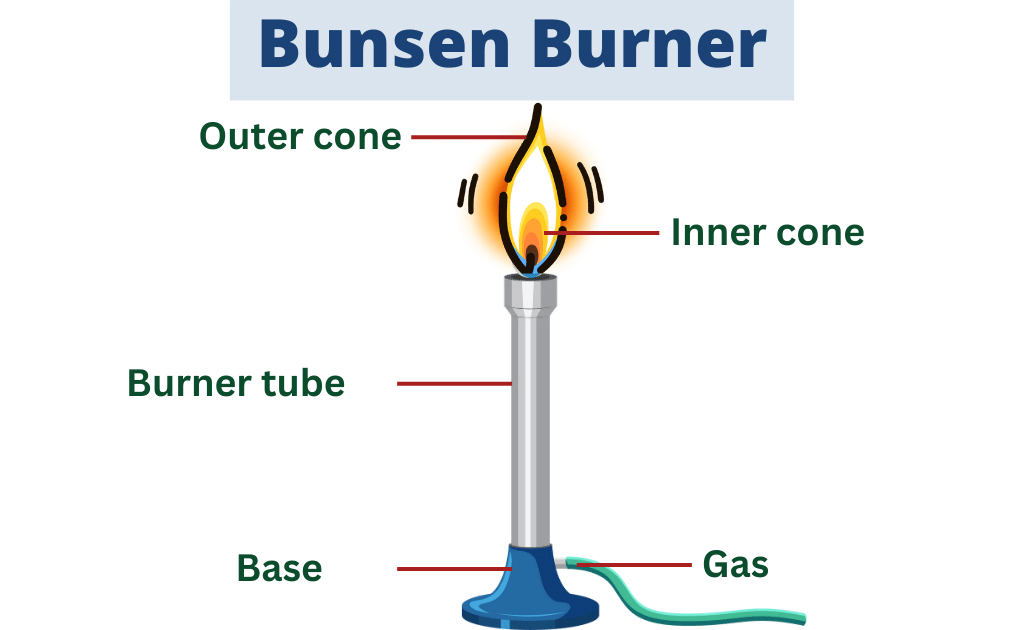Written By Adeel Abbas
Bunsen Burner is a laboratory device that is widely used in scientific research, teaching, and experimentation. It is a simple gas burner that produces a hot, blue flame that is perfect for heating, sterilizing, and combustion purposes.
Bunsen Burner Definition
Table of Contents
The Bunsen Burner is a laboratory device used to produce a single flame with adjustable heat output.
The device works by mixing gas and air in a controlled manner and then igniting it, resulting in a clean and efficient flame. The Bunsen burner was invented by Robert Bunsen in 1855.

Bunsen Burner History
In 1852, Robert Bunsen was hired by the University of Heidelberg and promised a new laboratory building. The city of Heidelberg was installing coal-gas street lighting, so the university laid gas lines to Bunsen’s new lab.
Bunsen wanted to improve existing laboratory burner lamps by making them more economical, simple, and able to reach high temperatures using coal gas as fuel. He worked with the university’s mechanic, Peter Desaga, to develop a new burner.
The Bunsen/Desaga burner produced a hot, clean, and non-luminous flame by mixing air and gas before combustion. Desaga engineered adjustable air slits at the bottom of the cylindrical burner, with the flame emitting from the top.
When the building opened in early 1855, Desaga had made 50 burners for Bunsen’s students. Just two years later, Bunsen published a description of the burner, and it quickly became popular among his colleagues. Today, Bunsen burners are used in laboratories all over the world.
In the late 19th and early 20th centuries, Bunsen burners were adapted to use natural gas and propane, which became more widely available. Bunsen burners were also improved with features such as safety valves and pilot lights.
Today, Bunsen burners are still an essential tool in many laboratories. However, there are also a number of newer laboratory heating devices available, such as electric hot plates and mantle heaters. Bunsen burners are still used because they are inexpensive, easy to use, and produce a very hot flame.
Developments In Bunsen Burner Technology
Here are some of the most recent developments in Bunsen burner technology:
- Electronic Bunsen burners: These burners use electronic controls to regulate the flow of gas and air, which produces a more consistent flame.
- Bunsen burners with built-in safety features: These burners have features such as flameout protection and automatic shut-off, which can help to prevent accidents.
- Bunsen burners for specialized applications: There are now Bunsen burners that are designed for specific applications, such as microchemistry and combustion analysis.
Bunsen Burner Parts
The Bunsen Burner consists of several parts, each with its own function. These parts include:

- Base: The base is a heavy metal stand that provides support and stability to the Bunsen burner. It also helps to protect the laboratory surface from the heat of the flame.
- Gas inlet: This is the point where the gas supply, such as natural gas or propane, is connected to the Bunsen burner. The gas inlet is typically located at the bottom of the Bunsen burner.
- Needle valve: The needle valve controls the flow of gas into the burner tube. By adjusting the needle valve, you can control the size and intensity of the flame.
- Air vent: The air vent controls the flow of air into the burner tube. The amount of air mixed with the gas determines the type of flame produced. A flame with more air will be hotter and more blue, while a flame with less air will be cooler and more yellow.
- Burner tube: The burner tube is the main part of the Bunsen burner where the gas and air mixture is ignited to produce a flame. The burner tube is typically made of metal and is designed to withstand high temperatures.
Bunsen Burner Flame
The Bunsen burner flame is a hot, blue flame that is perfect for heating, sterilizing, and combustion purposes. It is a non-luminous flame, which means that it does not produce soot.
The flame consists of three parts: the inner cone, the outer cone, and the non-luminous zone.
The inner cone is the hottest part of the flame, reaching temperatures of up to 1,500 °C (2,700 °F). It is the ideal part of the flame to use for heating and combustion.
The outer cone is cooler than the inner cone, and it is used for sterilization. It is also used to complete the combustion of any remaining gas that was not burned in the inner cone.
The outer cone of the Bunsen burner flame has two main functions:
- Sterilization: The outer cone is cooler than the inner cone, so it is ideal for sterilizing laboratory equipment. The heat from the outer cone kills any microorganisms that may be present on the equipment.
- Complete combustion: The outer cone also helps to complete the combustion of any remaining gas that was not burned in the inner cone. This helps to prevent the production of soot and other harmful pollutants.
The inner cone of the Bunsen burner flame is hotter than the outer cone. This is because the inner cone is where the gas and air mixture is first ignited. The outer cone is cooler because it further away from the heat source and is exposed to more air.
The outer part of the flame is hotter because it is exposed to more oxygen. Oxygen is necessary for combustion, and the outer cone of the flame has more oxygen than the inner cone.
The needle valve controls the flow of gas into the Bunsen burner. By adjusting the needle valve, you can control the size and intensity of the flame.
The flame of a Bunsen burner turns yellow when there is too little oxygen in the mixture. This can happen if the needle valve is closed too far or if there is a blockage in the air vent.
6 Types of Bunsen Burners
There are different types of Bunsen Burners available, including:
1. Portable Bunsen burner
It is most common type of Bunsen burner used in a variety of laboratory applications. Small and lightweight, making it easy to move around. Typically powered by natural gas or propane.
2. Strike back Bunsen burner
It is designed to be used in places where there is a risk of gas leaks. Has a special feature that prevents the flame from striking back into the burner tube. Typically used in industrial settings.
3. Electric Bunsen burner
It is powered by electricity instead of gas. Safer and more environmentally friendly than gas-powered Bunsen burners. More expensive and less versatile than gas-powered Bunsen burners.
4. Meker burner
It produces a hotter and more uniform flame than a standard Bunsen burner. Often used in laboratories for heating samples and conducting combustion reactions.
5. Fisher burner
Fisher burners use forced air to create a hotter flame. They are often used in industrial settings for heating and melting metals.
6. Tirrill burner
It has a disc valve at the base of the burner tube that controls the flow of gas. Often used in schools and universities for teaching students about laboratory safety and procedures.
Functions
Here are some of the specific functions of the Bunsen burner:
- Heating liquids: The Bunsen burner can be used to heat liquids for a variety of purposes, such as dissolving chemicals, conducting chemical reactions, and preparing samples for analysis.
- Sterilizing laboratory equipment: The Bunsen burner can be used to sterilize laboratory equipment by exposing it to a high temperature flame. This helps to prevent the spread of contamination in the laboratory.
- Conducting combustion reactions: The Bunsen burner can be used to conduct combustion reactions, which are chemical reactions that involve the burning of a substance in oxygen. Combustion reactions are used in a variety of laboratory experiments, such as identifying substances and measuring the energy content of fuels.
Also read:
- Desiccator-types, principle, applications
- Autoclave-types, principle, applications
- Microscope-types, principle, applications
- pH Meter-types, principle, applications
- Centrifuge-types, principle, applications
- Calorimeter- Types, principle, working, uses
- Spectrophotometer: Principles, Working, Types, and Uses
- Test Tube: Working, Types, and Uses
FAQs
How to use a Bunsen Burner?
To use a Bunsen Burner, first connect the gas supply to the gas inlet, and then adjust the air vent and needle valve to get the desired flame. Finally, ignite the flame using a striker or a match.
How to light a Bunsen Burner?
To light a Bunsen Burner, turn on the gas supply and adjust the air vent and needle valve to get the desired flame. Finally, use a striker or a match to ignite the flame.